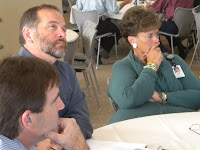A physician friend writes:
Last night I was traveling back from California to Ohio. As we landed in Denver, there was severe weather in the area--mostly rain and lightning--but also some minor hail.
FAA regulations require that, with any hail, every plane has to be inspected. I heard some of the ground crew bemoaning the fact that they had to do this, that it was a waste of time, as we loaded onto our connecting flight.
After the 30 minute inspection, the pilot explained to us that they found some minor damage on the plane from the hail and, therefore, we would have to get on another plane. Most likely, this damage would have never amounted to anything.
Deplaning at 11:30 at night for people headed east who were tired and grumpy was not a popular procedure. But it was the right thing to do. They were forced to put safety first. It wasn't what any of us wanted last night--but in the light of day, I am much happier being alive and back with my family--even if three hours later than anticipated.
It made me think--how often do we in health care push forward, ignore possible safety/quality issues, out of convenience or concern of causing someone temporary discomfort?
Last night I was traveling back from California to Ohio. As we landed in Denver, there was severe weather in the area--mostly rain and lightning--but also some minor hail.
FAA regulations require that, with any hail, every plane has to be inspected. I heard some of the ground crew bemoaning the fact that they had to do this, that it was a waste of time, as we loaded onto our connecting flight.
After the 30 minute inspection, the pilot explained to us that they found some minor damage on the plane from the hail and, therefore, we would have to get on another plane. Most likely, this damage would have never amounted to anything.
Deplaning at 11:30 at night for people headed east who were tired and grumpy was not a popular procedure. But it was the right thing to do. They were forced to put safety first. It wasn't what any of us wanted last night--but in the light of day, I am much happier being alive and back with my family--even if three hours later than anticipated.
It made me think--how often do we in health care push forward, ignore possible safety/quality issues, out of convenience or concern of causing someone temporary discomfort?






























